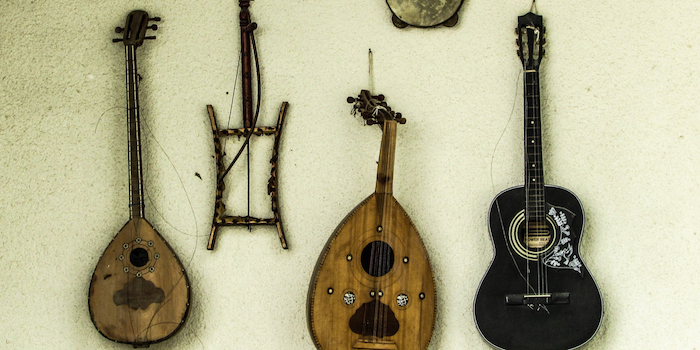Acoustic Guitar History
 Various Stringed Instruments
Various Stringed InstrumentsInterested in acoustic guitar history? If so, you might be curious to know that although the acoustic guitar in its current form is a relatively recent invention, a glance at the history of stringed instruments clearly shows that the basic form of the guitar has been around for thousands of years.
Ancient Origins
The earliest origins of the guitar can be traced back to the ancient world, Mesopotamia to be exact, with the invention of an instrument known as a tanbur. The tanbur was developed around 2,000 B.C. It had a long neck and a body that was made from a gourd or turtle shell with only three or four strings. Players would either pluck the strings with their fingers or use a makeshift plectrum (pick).
In time, similar types of instruments would arise in different countries. In Egypt, for example, they would develop and instrument known a kithara, an instrument similar to the tanbur. The kithara would evolve and be adopted by the ancient Greeks with a larger body and more strings. It would often be played while seated.
The Lute
While ancient civilizations had guitar-like instruments that are clearly similar to an acoustic guitar, technically speaking, most historians maintain that the modern guitar's
ancestry can be traced to the European lute and the oud, both used as
accompaniment instruments. The lute had a fretted neck and is characterized by its pear-shaped body.
Some have argued that the lute and
guitar have separate lineages with the guitar's ancestors having a
greater impact on the lute instead of the other way around.
The Vihuela
One of the most important ancestors
of the modern guitar is a Spanish instrument known as a vihuela, which
had six groupings (or courses) of strings (the 12 string guitar actually
predates the six string!) and was tuned in fourths (the guitar is
mostly tuned in fourths with the G-B strings being an exception). Its
body shape also resembled our modern guitar.
The Baroque Guitar
While the popularity
of the vihuela began to wane, the Baroque guitar (a five course
instrument) rose in prominence, though they were used as rhythmic
support in ensembles rather than as solo instruments. The Renaissance
guitar, a less ornate instrument, generally had four courses. At the
time, guitars generally had no more than 8 frets that were free from the
body and could be played easily.
By the latter part of the 18th
century, the guitar had become a six course instrument, with the double
courses being replaced by single strings. By this time, the guitar's
standard tuning (E-A-D-G-B-E, low to high) was in place and has been
ever since.
Antonio Torres and His Influence
Without question, the most significant changes to the
acoustic guitar were introduced during the 19th century by the Spanish
luthier Antonio Torres, who made significant changes in the way the
guitar was constructed (he invented the still popular fan bracing
pattern), increasing the size of the body (making it a viable solo
instrument) as well as changing the instrument's proportions to make it
more comfortable for performers. Torres's contributions are still the
standard for classical guitar construction to this day and are a significant part of acoustic guitar history.
Experimentation
As
Torres's innovations became the foundation for classical instruments,
other luthiers (most notably CF Martin and Orville Gibson) began
experimenting with construction techniques that would ultimately improve
the guitar's capabilities as a solo instrument.
Streel-String Guitars
As the guitar's
popularity increased, so did the desire to use it as a solo instrument.
Unfortunately, in larger ensembles, nylon-string guitars generally
don't cut through a mix unless external amplification is used, which
wasn't available at this time. While steel strings were available around
1900, the Torres-based classical instruments were unable to bear the
increased tension. CF Martin, the founder of Martin Guitars, offered an
X-braced pattern which could handle the string tension and became the
standard still in place for steel string acoustic guitar construction. The benefits of the industrial revolution affected the guitar industry as well with more consistent forms of production becoming available.
Archtops
What
CF Martin did for flat-top acoustic steel string guitars Orville Gibson
(and Gibson employee Lloyd Loar) did for the archtop guitar.
Essentially marrying an acoustic steel-string guitar with a
cello-inspired body, an archtop has a larger, hollow body, complete with
the f-holes as seen on violins, cellos, and other stringed instruments.
Archtop guitars also have floating, adjustable bridges, as opposed to
the fixed bridges of traditional classical or steel-string acoustics.
Acoustic Guitar History - Modern Innovations
The 20th century saw even more innovation with the acoustic guitar, with companies like Ovation exploring new construction techniques and aesthetics, and people like Bob Taylor challenging long-held conventions by exploring bolt-on neck construction with acoustic instruments. As any student of acoustic guitar history can see, the acoustic guitar is part of a beautiful story whose ending is far from being written.
Add Your Comments Here!
I'd love for you to be a contributor to SoMuchGuitar.com!
Just fill out the information below to add to this page. I'll be in touch about your submission soon!